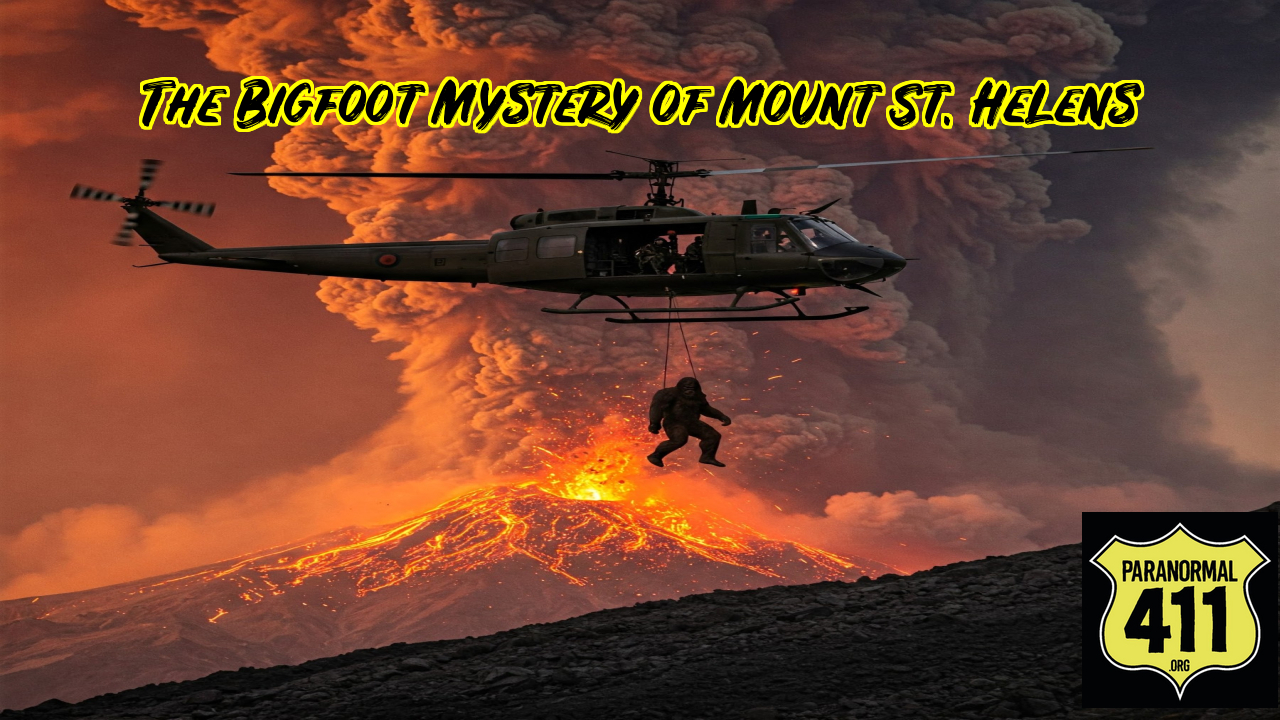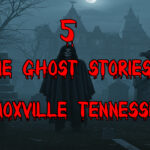
“May 18, 1980. A day etched into the Pacific Northwest’s memory. At 8:32 a.m., Mount St. Helens erupted with the force of 24 megatons of TNT—enough to level forests, vaporize lakes, and carve a crater a mile wide. The sky turned black. Ash rained down like toxic snow. But beneath the chaos, there’s a hidden chapter to this disaster.
“Because while the world focused on the volcano’s fury, rumors swirled about something else in the debris. Contractors reported soldiers guarding ash-coated bodies ‘too tall to be human.’ Medics spoke of bandaged figures in tents, their silhouettes hulking under dim lantern light. And pilots claimed helicopters airlifted cargo nets filled with… something… to a remote military base.
“Tonight, we’re not just talking about lava and landslides. We’re asking: Did the U.S. military rescue Bigfoot in the aftermath of Mount St. Helens? And why would they bother? To answer that, we need to rewind—way back—to a mountain steeped in mystery long before it blew its top. A mountain where Native tribes warned of ‘mountain devils,’ prospectors fought ape-like creatures, and hikers vanished without a trace.
“This isn’t just a story. It’s a collision of geography, history, and government secrecy. Over the next hour, we’ll stitch together tribal legends, declassified documents, and eyewitness accounts to build a case that something—someone—was on that mountain… and the military knew it.”
May 18, 1980. A serene Sunday morning in the Pacific Northwest. Birds chirp, mist clings to the ancient evergreens of Mount St. Helens—and then, at 8:32 a.m., the world explodes. The mountain’s north face detonates with the force of 24 megatons of TNT, blasting ash 15 miles into the sky. Forests evaporate. Rivers boil. Spirit Lake, once a mirror of alpine beauty, is buried under 200 feet of mud and debris. But in the chaos that followed, something stranger emerged. Contractors clearing debris near the Toutle River reported soldiers guarding tarps draped over ‘hairy, ash-coated bodies.’ Helicopters airlifted shrouded figures in cargo nets. Medics treated ‘bandaged patients’ over eight feet tall. Tonight, we ask: Did the U.S. military secretly rescue Bigfoot in the aftermath of this disaster?”
For over a century, Mount St. Helens has been ground zero for Sasquatch lore—from tribal legends of ‘mountain devils’ to prospectors battling ape-like creatures in the 1920s. Our goal tonight is to connect these dots. We’ll start with the volcano’s deep history of paranormal activity, then explore how the 1980 eruption created the perfect storm for military intervention. By the end, you’ll decide: Is this myth… or hidden history?”
“But first, let’s rewind. Long before the eruption, Mount St. Helens wasn’t just a volcano—it was a cryptid crossroads. To understand why the military might intervene, we need to prove Bigfoot’s undeniable presence in these woods. Strap in. We’re starting with the stories that built this legend.”
“Long before settlers arrived, the Cowlitz people shared stories around campfires of creatures they called ‘mountain devils’—tall, hairy beings that roamed the slopes of Loowit, what we now call Mount St. Helens. Imagine the dense, ancient forests of the Pacific Northwest, shrouded in mist and volcanic fog. To the Cowlitz, this was no ordinary mountain. It was a place of spirits, a threshold between worlds.
These ‘devils’ were described as 9 to 10 feet tall, covered in coarse hair, with glowing eyes that pierced the darkness. They moved silently, vanishing before dawn, leaving only oversized footprints in the mud. The tribes didn’t fear them—they respected them as guardians of the wilderness. But they warned: Do not linger in the high caves after sunset.
This wasn’t superstition. It was a lived truth, passed down through generations. And in 1924, that truth collided with the modern world.”
July 1924. Five gold prospectors—Fred Beck, Marion Smith, his son Roy, Gabe Lefever, and John Peterson—are camped in a remote gorge near Spirit Lake. The air smells of pine and sulfur. They’re miles from civilization, their only shelter a rough log cabin.
One afternoon, Fred Beck and a companion hike to a spring. As they fill their canteens, they hear rustling. Beck turns—and freezes. A 7-foot-tall creature, covered in blackish-brown hair, stands 30 yards away. It doesn’t walk like a bear. It strides upright, like a man. Beck raises his rifle. Three shots ring out. The creature staggers, then vanishes into the trees.
That night, the men huddle in their cabin. Midnight strikes. Suddenly—THUD. THUD. THUD. Rocks slam against the walls. The roof groans under the weight of something massive. Through gaps in the logs, they see shadows—multiple shadows—lurching outside. A hairy arm bursts through a hole in the wall, grasping for an axe. Beck wrestles it free.
For six hours, the miners fire rifles through the roof and door. Over 50 rounds spent. At dawn, they flee, abandoning $200 in supplies—a fortune in 1924.
But this wasn’t a campfire tale. In 2013, researcher Marc Myrsell hiked to the cabin site. Using metal detectors, he unearthed .30-30 Winchester rifle casings—exact matches to the guns Beck described. Physical proof of their battle.
Beck later wrote, ‘These beings weren’t animals. They were something… other.’ His 1967 book, I Fought the Apemen of Mt. St. Helens, claimed they were interdimensional. But for locals, the message was clear: Something lived in those woods.”
“The Ape Canyon incident wasn’t a one-off. In 1950, a young skier named Jim Carter—or Joe Carter, records conflict—vanished near the same gorge. Search teams found his tracks leading straight toward the canyon’s edge, as if he’d been dragged. No body was ever recovered.
By the 1970s, sightings surged. Loggers along the Lewis River reported 18-inch footprints pressed deep into riverbanks. Hikers described guttural growls and a ‘musky, rotting-meat stench’ near Spirit Lake. Even park rangers—trained observers—admitted finding strange tracks.
Then came the Patterson-Gimlin film in 1967. You’ve all seen the grainy footage: a hairy, female Sasquatch striding through a California creek. It wasn’t from Mt. St. Helens, but it electrified the Pacific Northwest. Suddenly, Bigfoot wasn’t folklore—it was a cultural phenomenon.
“For decades, the woods whispered. Then, on May 18, 1980—the mountain screamed. But in the chaos of ash and fire, the old stories took a darker turn. Because when the military arrived, they weren’t just rescuing people…”
“At 8:32 a.m. on May 18, 1980, Mt. St. Helens erupted. The north face of the mountain collapsed in the largest landslide ever recorded, unleashing a pyroclastic flow that incinerated 230 square miles of forest. Imagine towering evergreens snapped like matchsticks, Spirit Lake boiled into a toxic stew, and ash plumes so thick they blotted out the sun across three states.
But beneath this devastation, something else stirred. Contractors working near the Toutle River reported eerie sights: soldiers guarding tarps draped over massive, ash-coated shapes. One worker swore he saw a hairy, human-like hand protruding from under the canvas—a hand far larger than any bear’s.”
“The U.S. military descended swiftly—Army Corps of Engineers, National Guard, Air Force. Officially, they were there for rescue, debris removal, and restoring order. But whispers swirled. In the volcano’s remote blast zone, shielded by ash clouds and landslides, other operations unfolded.
“A logging crew working near the Toutle River stumbled upon a surreal scene: soldiers guarding two large, tarp-covered shapes in the ash. One contractor, who asked to remain anonymous, described ‘a strong, rotting smell’ and a glimpse of ‘a hairy arm sticking out from under the tarp—thick, like a man’s but covered in coarse black hair.’ When he asked a soldier what they’d found, the reply was terse: ‘You don’t want to know.’”
“A retired Army pilot, speaking anonymously in a 2008 podcast interview, recalled airlifting ‘unmarked cargo nets’ from the eruption zone to Joint Base Lewis-McChord. He said, ‘The nets were heavy—way heavier than debris. Once, a corner flapped open mid-flight, and I saw a foot. Not human. Too large, toes splayed like a primate’s.’ When he questioned his commander, he was told, ‘Classified. Focus on your job.’
“A volunteer medic named ‘Karen’ (pseudonym) described a triage tent near Coldwater Creek where she assisted military doctors. She recounted: ‘They brought in three figures on stretchers, covered head-to-toe in bandages and Army overcoats. One was over 8 feet long. I saw a hand—thick fingers, black nails, coarse hair poking through the gauze. A doctor snapped, “*Stay back—this one’s contagious.” I was ordered to leave the tent.’”
“She remembered the smell: burnt hair and something metallic, like copper.”
“A guardsman stationed near Spirit Lake reported seeing ‘tall, hunched figures’ being led into a temporary hangar. He told researchers in 2012: ‘They were wrapped in gray blankets, walking upright but stumbling. One blanket slipped, and I saw a shoulder—hairy, ash-gray, way too broad for a human.* My sergeant grabbed me and said, “Eyes forward, soldier. This never happened.”
“A retired airman described escorting ‘non-human entities’ during post-eruption ops: ‘We were told to secure a hangar at Lewis-McChord. Two figures walked in—over 8 feet tall, covered in heavy coats.* Their gait was… off, like their knees bent backward. We were debriefed and threatened with court-martial if we talked.’
“In 2004, a researcher filed a FOIA request for Mt. St. Helens recovery logs. The response: ‘No records responsive to your request.’ Yet the same logs detail helicopter deployments to ‘unmarked LZs’ in the blast zone.”
“Let’s start with the ground beneath our feet. Ape Canyon. Spirit Lake. The Toutle River Valley. These places aren’t just coordinates on a map—they’re the beating heart of this story.
Before 1980, these were the hotspots: where Fred Beck fought off ape-men in 1924, where the Cowlitz tribe warned of ‘mountain devils,’ where loggers found 18-inch footprints in the 1970s.
And after the eruption? These same valleys were swarming with military helicopters, medics, and guarded recovery teams.
Coincidence?
Or evidence that the government knew exactly where to look?”
“Now, let’s talk survival.
Pre-1980, Bigfoot was described as nocturnal. Cave-dwelling. Elusive. Imagine these creatures when the mountain blew.
Picture them: huddled in lava tubes as the earth shook. Crawling out after the blast, burned, starving, and exposed. The forests they relied on? Gone. The caves? Collapsed.
Who else had the resources to intervene? The military. Medics treating ‘bandaged figures’ in tents? Airlifts to secret bases? This isn’t fantasy—it’s practical.
If Sasquatch existed, the eruption forced them into the open. And the government had to clean up the mess.”
“But why?”
“Rewind to 1979.
Mt. St. Helens wasn’t just a volcano—it was a paranormal tourist trap. Guided Bigfoot hikes. Campfire ghost stories. Merchandise.
The Patterson-Gimlin film had already burned ‘Bigfoot’ into America’s brain. The public expected weirdness here.
So when the mountain blew, the military didn’t just face ash and landslides. They faced a cultural powder keg.
If they found Sasquatch, secrecy wasn’t just possible—it was mandatory. No press leaks. No headlines. Just helicopters, tarps, and orders to stay quiet.”
“Sound familiar?”
“Let’s cut to the why.
Why would the military care about Bigfoot?
First: The Endangered Species Act. Passed in 1973. If Sasquatch were real, protecting them fits the era’s green wave.
Second: Cold War paranoia. Imagine the Soviets learning we’d discovered a new hominid. The race to weaponize it. Study it.
Third: Fear. Not of Sasquatch—of us. How would the public react? Churches? Schools? Chaos.
The government’s job isn’t truth—it’s stability. And in 1980, stability meant hiding the unimaginable.”
“Still think it’s a stretch?”
“Let’s talk about the people.
Fred Beck and his miners had nothing to gain by lying. They lost money, tools, and nearly their lives.
The Cowlitz tribe’s stories? Centuries old. No YouTube clicks. No merch sales.
And post-eruption? Contractors—loggers, engineers—men who knew bears, who knew the woods. Their quote? ‘I’ve seen bears. This wasn’t a bear.’
Even a retired USAF airman admitted: ‘We were told to never discuss what we saw.’
These aren’t UFO kooks. These are eyewitnesses. People with nothing to gain and everything to lose.”
“Finally, let’s talk history.
The U.S. government has form here. UFOs? Project Blue Book. Mind-control experiments? MKUltra.
FOIA requests about Mt. St. Helens recovery ops? Denied. ‘National security.’
Whistleblowers? Silenced. Paper trails? Gone.
This isn’t speculation—it’s standard practice.
If the military rescued Bigfoot, they’d do it the same way they hid nuclear accidents or spy planes: efficiently. Quietly. Brutally.”
“So why does this theory hold?
Because the geography matches.
The behavior aligns.
The secrecy fits.
The military wasn’t just on Mt. St. Helens to save humans.
They were there to clean up a disaster nobody could explain.
And maybe—just maybe—to help a species we’re still not ready to admit exists.”
“Ask yourself: If you were in charge…
Wouldn’t you do the same?”
“From the mist-shrouded forests of Ape Canyon to the ash-choked valleys of 1980, this story isn’t just about what happened—it’s about what lingers.
The Cowlitz tribe’s ‘mountain devils’ didn’t vanish when the prospectors fled. Fred Beck’s rifle casings didn’t dissolve in the rain. The eruption didn’t erase the mystery—it etched it deeper into this land.”
“And today? Joint Base Lewis-McChord still stands. The Cascades’ remote valleys remain restricted. FOIA requests still get denied.
The legacy isn’t buried. It’s breathing. Waiting.”
“In 2013, a researcher named Marc Myrsell hiked into Ape Canyon with a metal detector. What did he find? Rusted rifle casings from the 1920s. A cabin’s iron hinges. Tangible proof of Fred Beck’s nightmare.
And last year? Hikers near the Toutle River reported low, rumbling growls—sounds that defy biologists. Sounds that match exactly what the Cowlitz described centuries ago.
The mountain isn’t done speaking. It’s testing us. Daring us to listen.”
“So here’s the question I leave you with:
When you stand at the edge of a forest—when you feel the chill of a shadow you can’t explain—will you shrug it off?
Or will you remember Ape Canyon? Remember the miners. The medics. The whispers of a base called Lewis-McChord.
Will you dismiss it as a tale?
Or will you wonder…
…if the legacy isn’t just alive.
But watching.”

 5 True Ghost Stories of Knoxville Tennessee
5 True Ghost Stories of Knoxville Tennessee  The Minds Last Stand: The Third Man Factor
The Minds Last Stand: The Third Man Factor  Shadow Figures: They’ve Been Watching You All along
Shadow Figures: They’ve Been Watching You All along  The Bigfoot Mystery of Mt Saint Helens
The Bigfoot Mystery of Mt Saint Helens  Bigfoot’s Hidden Rage: Why some Encounters turn Deadly
Bigfoot’s Hidden Rage: Why some Encounters turn Deadly  Cheating Death at the Quantum Level
Cheating Death at the Quantum Level  Into the Unknown: Exploring the Michigan Triangle
Into the Unknown: Exploring the Michigan Triangle  The Shag Harbour UFO Incident
The Shag Harbour UFO Incident